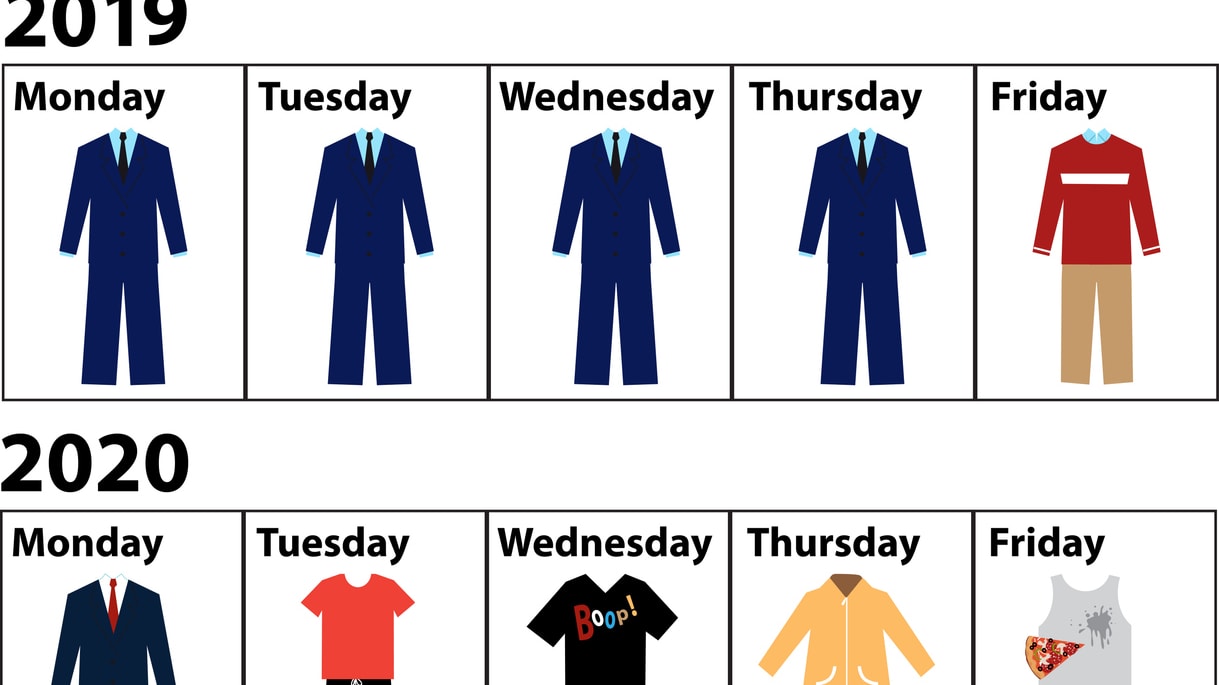A year and a half of remote work allowed many employees—over Zoom meetings and the like—to wear pajamas, sweatpants and T-shirts as acceptable professional wear. Some employees even stopped wearing pants as videoconference calls allowed for greater flexibility in wardrobe selection.
Those dress-down days may be coming to a close, however, as many companies begin returning to in-person work. The transition to the physical workspace has forced managers to confront a difficult task: how to reinforce expectations around professional clothing after more than a year of relaxed dress codes.
Ben Lamarche, general manager of Lock Search Group, a recruiting firm in Toronto, decided to make the flexibility of remote work permanent in his office's dress code. Lock Search Group already had "Flexible Fridays" before the pandemic, where employees could dress in business-casual clothing to celebrate the end of the workweek.
As the pandemic subsided and people returned to the worksite, Lamarche changed his dress code to a full-time flexible model, where employees could use their own judgment about what is appropriate to wear in the office.
Lamarche did not provide any official guidelines when he changed the dress code, but his employees have adjusted—opting to wear button-down shirts instead of suits and switching out dress shoes for slip-on sneakers.
"We haven't had a case of someone coming to the office with sweats, flip flops, Crocs or sleeping T-shirts," said Lamarche. "Our people have approached the policy modestly and reasonably."
Lamarche said the decision has benefited employees' well-being without sacrificing professionalism.
"It is finally evident that although you do need to be professional and make a good impression, you don't have to be dressed to the nines to be productive or to do good work," Lamarche said.
Employers have embraced more informal dress codes in recent years, according to Harvey Linder, an employment lawyer at Culhane Meadows PLLC in Atlanta, who helps companies write employee handbooks and dress codes.
[Want to learn more about managing people? Join us at the SHRM Annual Conference & Expo 2021, taking place Sept. 9-12 in Las Vegas and virtually.]
That trend continued during the pandemic. Nearly two-thirds of U.S. workers polled who were working remotely during the COVID-19 pandemic were wearing more casual clothes. Seventeen percent wore pajamas as their typical daily work attire, according to a Society for Human Resource Management poll conducted with NORC, an independent research organization.
"I think the bottom line is we are going to be far more relaxed when we go back," Linder said.
Other managers have opted to gradually return to pre-pandemic dress norms. Robert Johnson, founder of Sawinery, a woodworking supply company based in Connecticut, is doing just that.
Sawinery's dress code will allow employees to wear casual clothing for three days of the week, while formal dress will be required for the other two. Johnson's definition of "casual" allows employees to wear jeans and collared shirts on casual days and more formal attire—such as suit jackets and dress pants—during the other two days of the week.
Johnson said he plans to use this system for the first month of in-person work to help his employees reacclimate to dressing up.
"This plan is so we can give freedom to employees without sacrificing their productivity," Johnson said. Sawinery will increase the number of formal dress code days each month until employees are back to wearing formal professional wear full time, according to Johnson.
Anthony Martin, CEO of Reno, Nev.-based insurance agency Choice Mutual, opted to reinstate his company's pre-pandemic dress code when his employees returned to the office.
"I believe that professional attire is an important psychological element of staying productive and maintaining the correct mindset for the task at hand," Martin said. "While we're more than capable of carrying out our responsibilities in loungewear, it doesn't cultivate the best working environment or set a proper example."
Martin sent a reminder e-mail to his employees before they returned to the office about expectations for their clothing choices. They took the news positively, he said.
Studies have found that adhering to a formal dress code can increase productivity among workers. Scientific American reported in 2016 that wearing formal attire has been linked with increases in abstract thinking and higher rates of success in business negotiations.
Linder recommends that managers set clear expectations before employees return to in-person work so that any new dress guidelines don't come as a surprise while employees handle other challenges of returning to the worksite.
"Employers certainly are entitled to respect from their employees, but I also think employers have to be fair in setting expectations," Linder said. "Employees have been so used to being in shorts and sweatpants for the last year [that] whether it's consciously or unconsciously, they're going to push the issue."
Written guidance can be especially helpful.
Linder recommends that managers send out memos with guidelines on any changes to dress code sections of employee handbooks, as well as reminders about clothing expectations.
"It's very important for employers to make certain that the employees understand what behavior is expected of them," Linder said.
Kelly Anderson is a freelance writer based in Washington, D.C.
Was this resource helpful?




